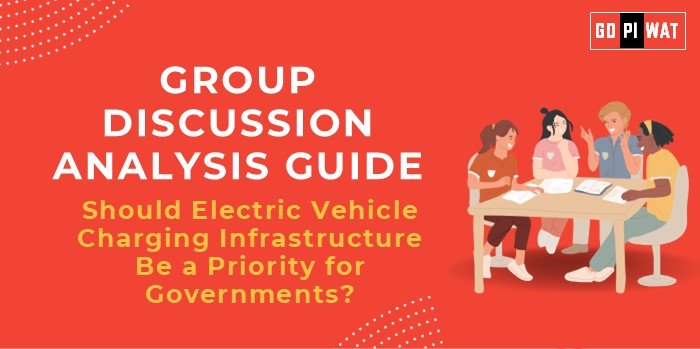📋 Group Discussion (GD) Analysis Guide
⚡ Should Electric Vehicle Charging Infrastructure Be a Priority for Governments?
🌍 Introduction to the Topic
Opening Context: The global transition to electric vehicles (EVs) has become a focal point in combating climate change and reducing dependency on fossil fuels. Developing an EV charging infrastructure is critical for sustaining this shift, aligning with global environmental and energy efficiency goals.
Topic Background: Electric vehicles offer a cleaner alternative to conventional vehicles, but their adoption faces hurdles like range anxiety and inadequate charging networks. Many governments worldwide are implementing policies and investments to prioritize charging infrastructure as a part of their sustainability agenda.
📊 Quick Facts and Key Statistics
- Global EV Sales: 14 million in 2023, up from 10 million in 2022 (IEA).
- India’s EV Market Growth: CAGR of 49% forecasted till 2030 (NITI Aayog).
- Charging Stations in India: 6,586 public chargers operational by 2024, with a goal of 100,000 by 2030.
- Carbon Reduction Potential: EV adoption could cut global CO2 emissions by 3.5 Gt annually by 2050.
- Government Incentives: $12 billion global investment in EV infrastructure in 2022 alone.
👥 Stakeholders and Their Roles
- Governments: Create policies, provide subsidies, and develop public charging infrastructure.
- Private Sector: Innovate in technology and expand the charging network.
- Consumers: Adopt EVs, influencing demand.
- International Agencies: Facilitate knowledge-sharing and fund global initiatives.
🏆 Achievements and Challenges
🌟 Achievements:
- Pioneering Examples: Norway leads with 80% EV penetration in new car sales (2023).
- Policy Milestones: India’s FAME-II scheme allocated ₹10,000 crore for EV adoption.
- Infrastructure Growth: China has 4.5 million public charging points, the largest globally.
⚠️ Challenges:
- High Initial Costs: Establishing a wide network of chargers is capital-intensive.
- Energy Demand: Increased EV adoption strains electricity grids.
- Uneven Distribution: Rural and underserved areas lack charging stations.
Global Comparisons:
- The US: Federal funding for 500,000 public chargers by 2030.
- Germany: Nationwide EV fast-charging corridors under its “Autobahn” project.
💡 Structured Arguments for Discussion
- Supporting Stance: “Investing in EV charging infrastructure is crucial to meet climate goals and transition away from fossil fuels.”
- Opposing Stance: “Prioritizing charging infrastructure might divert funds from other critical areas, such as healthcare and education.”
- Balanced Perspective: “While charging infrastructure is vital, governments must balance this with investments in clean energy and rural electrification.”
🚀 Effective Discussion Approaches
- Opening Approaches:
- Statistical Impact: “EVs could reduce India’s oil imports by $60 billion annually by 2030, emphasizing the need for charging infrastructure.”
- Case Study Reference: “Norway’s success with EV adoption stems from robust public charging networks.”
- Counter-Argument Handling:
- Highlight renewable energy integration to address grid strain.
- Argue for phased implementation and public-private partnerships to manage costs.
⚖️ Strategic Analysis of Strengths and Weaknesses
- Strengths: Environmental benefits, job creation in green industries.
- Weaknesses: High initial investments, dependence on fossil-fuel-powered electricity grids.
- Opportunities: Collaborations with private firms, integration with renewable energy sources.
- Threats: Technological obsolescence, economic disparity in access.
📚 Connecting with B-School Applications
- Real-World Applications: Sustainable infrastructure projects, green finance, and operational strategies for scaling EV adoption.
- Sample Interview Questions:
- “How can governments ensure equitable EV infrastructure distribution?”
- “What lessons can India learn from Norway’s EV adoption strategy?”
- Insights for B-School Students:
- Explore partnerships in sustainable energy sectors.
- Study policy frameworks for EV promotion and grid modernization.


